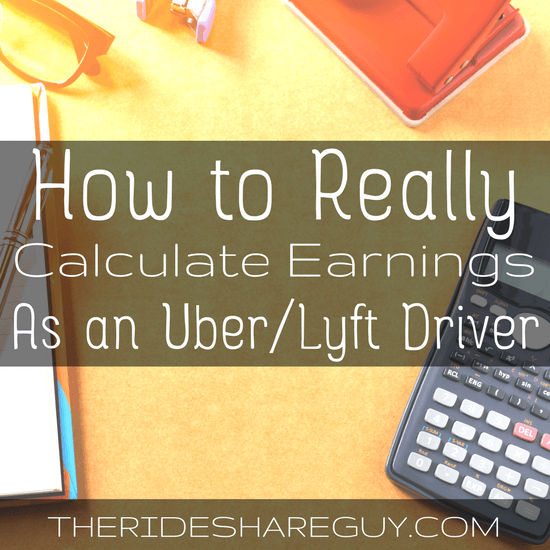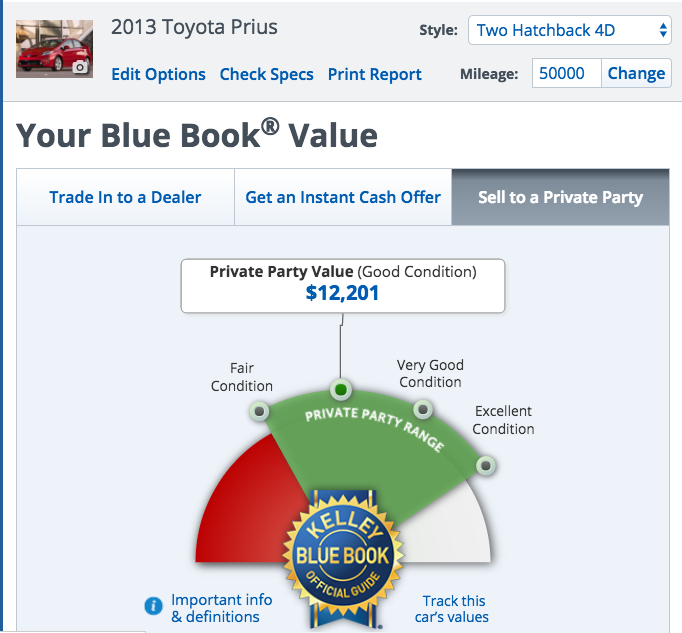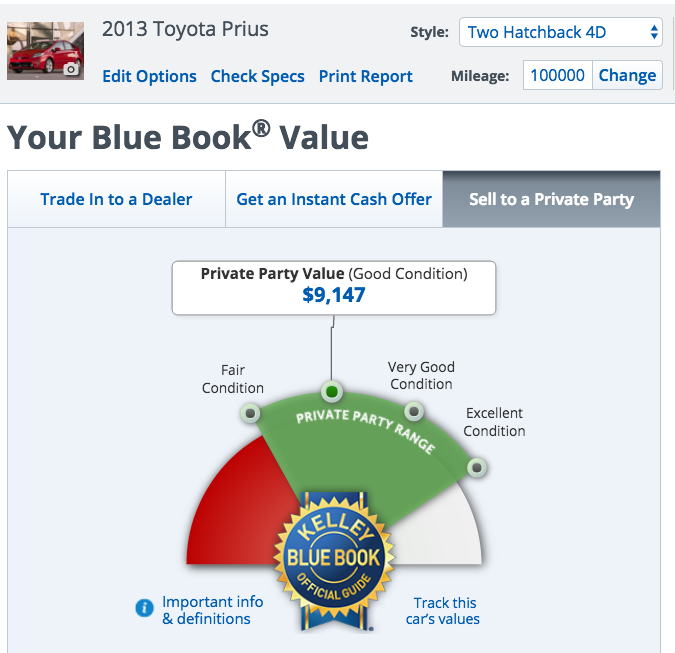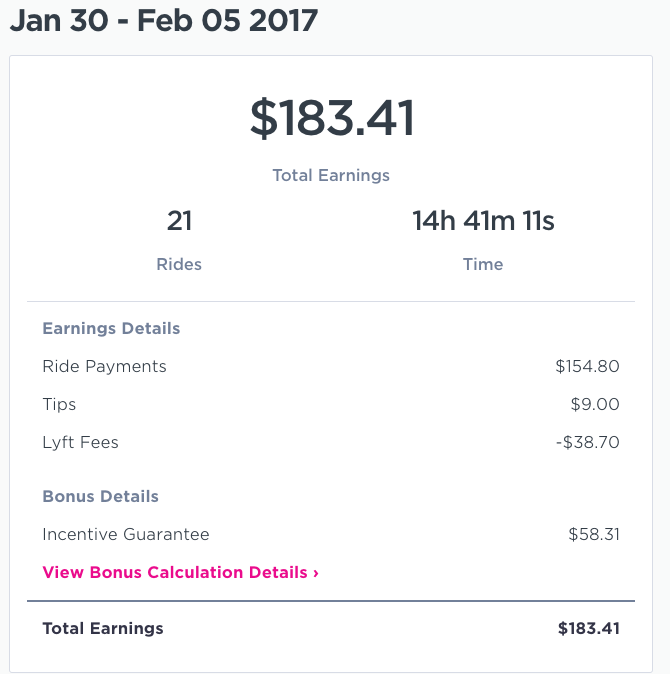Harry here. Our 2017 survey found that drivers reported making over $15.68 an hour before expenses but is that the best way to think about earnings? Today, RSG contributor Will Preston explains how to calculate per mile earnings instead of per hour.
Many drivers look at their Uber or Lyft paychecks, subtract their gas costs, and say “nice!” Uber and Lyft likely rely on this perception, because if enough drivers knew their real per-hour and per-mile rate, they might choose to do something else.
Other drivers track their mileage, multiply those miles by 53.5 cents (2017 Federal Mileage Reimbursement rate), subtract that amount from their earnings and think “I’m making less than minimum wage!”
However, the best way to calculate what you’re actually paid is a lot simpler than you may think. What you need to do is calculate your actual cost per mile and deduct that from your Uber and Lyft pay, and I’ll show you how.
In San Diego, I make the equivalent to $17.77 per hour after expenses, which is a lot higher than the California minimum wage of $10.50. To make that outside of Uber & Lyft, I would need to get a “real job,” instead of just working when I feel like it. So I’m happy with my hourly rate. It covers the car and insurance payments, and all I’m really giving up is some evening TV time.
What I felt I needed to know, though, was whether or not the amount of profit I was receiving was worth all those miles I was putting on my car. Knowing my per-mile profit also allows me to make changes to my driving strategy and see if I can improve it. Let’s see how I figured all of this out.
Know Your Costs
It doesn’t make sense to calculate your profit based off the IRS-provided value of 53.5 cents per mile since most cars cost a lot less to operate, but you do want to know how much it costs you to drive one mile.
The biggest cost that most people don’t factor in is depreciation in the value of your car. A car with 100,000 miles on it is worth less than one with 50,000 miles. Luckily, calculating this value is actually pretty easy.
- First calculate how many miles you would drive in a few years without rideshare driving (e.g. 50,000). Then calculate how many additional miles you are likely to put on your car during the same period because you are rideshare driving (e.g. 50,000).
- Then take these two numbers to Kelley Blue Book.
- Click on Check My Car’s Value.
- Select your car year and model using the first mileage figure, and store the resulting resale value. (I chose to use the Sale to Private Party number, but as long as you use the same one each time, it should be fine.)
- Then change the mileage to the second number (100,000 in this example) and write down that number.
- Subtract the two numbers, divide by the number of miles you used, and you have your per mile depreciation cost.
- For example, I showed that my 2013 Toyota Prius is currently worth $12,201 with 50,000 miles on it. Add another 50,000 miles and it would be worth only $9,147. Dividing the difference of $3,054 by 50,000 miles give me a per mile depreciation cost of $.061.
Maintenance and Tires
The next item I needed to find were the costs for maintenance and tires. Toyotas are pretty reliable and I don’t expect a whole lot in the maintenance department, but all these extra miles do increase my chances of needing maintenance.
I decided to err on the side of caution and start with the numbers AAA gives for the average maintenance and tire costs for 2015 — the latest year they give numbers for. They are $.0511/mile and $.0098/mile, respectively. I increased the maintenance costs to $.06/mile.
I then used a conservative high-end estimate for fuel prices of $2.75/gallon, and the actual calculated MPG on my car, which is 43 MPG to arrive at a per mile fuel price $.064. (Gas has actually been a little less than that, but I always want to err on the side of caution when doing things like this.)
This results in a per mile cost of $.195, using a 2013 Toyota Prius in San Diego.
Related article: Essential gear every rideshare driver should have
I then needed to calculate how much of my insurance costs are from rideshare driving. Since my car is used for personal reasons and rideshare driving, I did not include my entire insurance cost.
I included an increase of $206.40/year, which is how much my insurance increased when I told them I was driving for Uber and Lyft. Dividing $206.40 by 52 gives me a weekly additional cost of $3.96.
Since this is a weekly cost and not a per-mile cost, I didn’t want to use a per-mile calculation here, so I decided to deduct the weekly cost of this directly from the bottom line. That’s the purpose of the fixed costs section in the spreadsheet. If you have other fixed costs, you can add them there.
Related: Rideshare Insurance Options for Drivers
Mileage From QBSE
I use QuickBooks Self Employed, and it automatically tracks every time I’m moving anywhere. All I have to do is swipe left for personal or right for business, and then classify what type of business it was. Therefore, all I had to do was log into QuickBooks and click on the download button at the top of the list of my mileage.
Yes, that shows that I have deducted $11,801 in mileage since I started using the program six months ago. Yes, it’s important to track your mileage. If you track nothing else, track your mileage.
Know Your Revenue
Getting your revenue from Uber and Lyft is easy. Once your earnings have been completely calculated (usually around Tuesday of the following week), login and look at your earnings.
For Uber, login to partners.Uber.com and select the appropriate week under Pay Period. Your Trip Earnings are right there. It’s $283.17 in this example. I also earned $10 in cash tips.
For Lyft, login to Lyft.com, click Driving History, and select the appropriate week. You can see that I earned $183.41 from Lyft this week, including tips.
That means I earned a total of $476.58 in rideshare revenue for this weekend.
If you are like me and drive for both Uber and Lyft, you can’t use the hours on these statements as your driving hours, since each only has the amount you were online with their platform. But you can get an estimate by downloading the detailed Uber and Lyft summaries and look at the first and last trips you took. That doesn’t include the time spent waiting for the trip or the time spent performing the last trip, but it’s close. I drove 22 hours this past week.
Downloading the Quickbooks Self Employed mileage report for the week shows me that I drove 790.42 miles this week for Uber & Lyft. At $.195/mile that’s a cost of $154.00 for the weekend’s driving.
How Much Did I Make?
Subtracting $154.00 mileage costs and $3.96 insurance costs from $476.58 shows that I profited $318.62 this week. Not bad for part-time driving. Dividing that by 22 hours of driving shows an hourly profit of $14.48.
Dividing $318.62 by 790.42 miles of driving shows a per-mile profit of $.403.
Why is the Per-Mile Profit Important?
Like a lot of people, I drive Uber and Lyft part-time. Driving costs me two things: time and the cost of each mile. My time isn’t free per se, as I do have other things that I could be doing with my time. Therefore, I should always be aware that an hour of Uber and Lyft driving will net me about $15/hr after expenses. If an hour is worth way more than $15, then maybe I should reconsider driving for Uber.
But what a lot of people don’t calculate is the per mile cost. Unlike the cost of your time, every single mile you put on your car has a real, tangible cost. Therefore, I think it’s just as important — if not more important — to be aware of how much you are making for every mile you put on your car. What if you found out that you only netted five cents for every mile you put on your car? That would put rideshare driving in a whole new light.
Speaking of other things you could be doing with your time… Some say they should just quit Uber and Lyft and go get a “real job.” But comparing rideshare driving to a real job is a bit more difficult. Let me explain.
Comparing This to a “Real Job”
If I had a dollar for every time I read that Uber/Lyft drivers make less than minimum wage…. Let’s just say it happens a lot. Obviously that isn’t true – but it’s even less true than you think. This is because in the rideshare world, we often talk about our profit after tax, and in the “real job” world we usually talk about what we make before tax.
So to compare apples to apples, we have to reverse calculate how much pre-tax money we would need to make in a real job in order to make the same as we are making with our rideshare job. (Apologies to our overseas viewers. I only know US tax rates, but you’ll be able to plug in your tax rates.)
It’s a bit complicated, as it is the opposite of the way we normally do things. So hold on to your hats and read on.
First we need to decide what tax bracket we are dealing with. A real job making $13-16 an hour would put you in the 15% Federal Income Tax bracket, so we’ll use that for the calculations. To that 15% we need to add Medicare and FICA or self employment tax. Self employment tax is 12.4% (for rideshare drivers) and FICA is 6.2% (for a real job). Medicare is 1.45% for a real job and 2.9% for self employed folks.
That’s a total tax rate of 30.30% for rideshare drivers and 22.65% for the “real job.”
Next, we have to calculate our rideshare after tax profit (AKA “take home pay”). At 790.2 miles for the weekend, my mileage deduction is $422.87. Subtracting that from my total payments of $476.58 shows that I’ll only pay tax on $53.71 of the $318.62 of profit ($476.58 – $318.62), leaving $264.91 of untaxed profit.
Subtracting the self employment tax rate of 30.30% from the $53.71 gives me $37.43 after taxes. Adding $37.43 to $264.91 gives me an after-tax profit (AKA “take home pay”) of $302.35.
So how much would I have to earn in a real job where I am in the 15% tax bracket and work 22 hours in a week? We previously discussed that the total tax rate of a real job in the 15% tax bracket is 22.65%. If we divide $302.35 by 77.35% (100% – 22.65%), we get $390.88. Dividing $390.88 by 22 hours gives me $17.77.
Let’s do it in reverse to check the math. (It’s also a lot easier to understand, since this is the way we are used to thinking.) Making $17.77 per hour and working 22 hours gives you a gross pay of $390.88. A tax rate of 22.65% would subtract $88.53 from your gross to give you a take home pay of $302.35.
So basically you would have to be making over $3/hour more at a ‘real job’ to make the same amount as a rideshare driver in this scenario ($17.77 per hour vs. $14.48 per hour).
Found out you owe back taxes to the IRS? Ouch! If you owe the IRS and need help getting out of debt, check out Tax Closure. Tax Closure helps you reduce or eliminate IRS taxes you can’t pay. Best of all? Tax Closure’s employees are retired IRS agents, so they know exactly how to help you get relief or eliminate your IRS taxes. Check out Tax Closure here.
Final Thoughts
I work in San Diego, which doesn’t surge much compared to other markets. My records show I’ve gotten a surge fare on 10% of my rides, which added roughly 10% to my total gross. I averaged 1.97 rides per hour over the last four months. I guess what I’m saying is that I’m not in a market that’s tearing it up like San Francisco, Chicago, or New York. And yet I still managed to clear the equivalent of $17.77 per hour last week, working whenever and wherever I want. Not bad.
Add to this that most people commute to their job, which has a non-tax-deductible cost. If you do it right, every single mile you drive for Uber & Lyft is tax deductible. This should also be figured in when you compare rideshare driving to a real job.
I’ve attached the spreadsheet I used for my calculations. You should download the spreadsheet and do these calculations yourself. The first time using the spreadsheet will take a bit longer because you need to figure out and fill in your cost values. After that, this takes less than ten minutes per week.
I think it’s time well worth spending. If you’ve been keeping track of your miles by date, you can even go back and calculate these numbers for past weeks. Then you can see if your profit is improving or not.
Readers, what do you think of these calculations and do you use similar calculations to figure out if rideshare driving makes financial sense for you? Ask any questions you have in the comments, and we’ll answer them!
-Will Preston @ RSG
Save
Save
Save

















